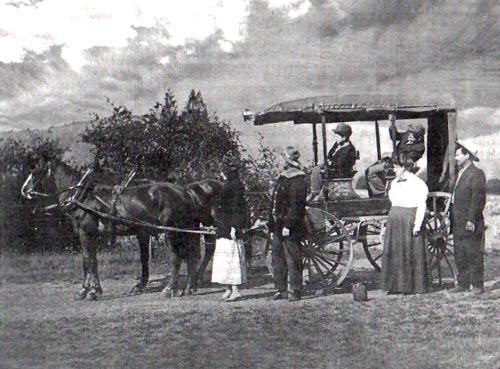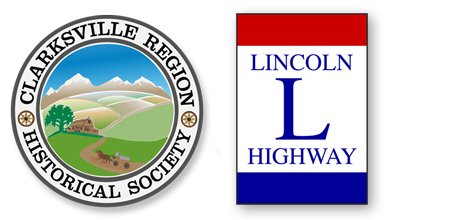A Brief History of Clarksville
By Dr. John E. Thomson
The area around what is now known as Clarksville was long inhabited by the Maidu and Miwok groups of Native American Indians. These indigenous people lived off the land, and resided in villages scattered over an area that extended from the Sacramento Valley up into the Sierra Nevada Mountains.
In January of 1848, James W. Marshall discovered gold in the millrace of Sutter's Mill at Coloma on the American River and touched off the California Gold Rush.
The Indians, though weakened by the malaria epidemic of the 1830s, were still residing in the Sierra Foothills when the early gold-seekers and others began to arrive in the late 1840s. The immigration caused by the Gold Rush destroyed the Indian's arcadian way of life as gold seekers overran the foothills.
In 1848 or 1849, the Mormon Tavern, offering rough hospitality for gold seekers, was built by a Mormon named Morgan in the area just south of the present community of El Dorado Hills. The tavern later acted as a remount station during the short life of the Pony Express, from April 1860 through October 1861.
About the same time the Mormon Tavern was built, a man named Clarkson had a stopping place near Mormon Tavern known as Clarkson's Village. Clarkson's Village was near the junction of the stagecoach road from Sacramento and the freight road east to the Sierra mines which brought people, news, supplies, and mail to the gold fields. The town soon became the commercial and social center for the area, and boasted of four hotels in its heyday. By 1855 a post office was established there, and in the process the postal authorities renamed the town Clarksville.
By 1860 the Gold Rush boom was fading. In the process, the area around Clarksville moved to a more agricultural economy, and ranching become the major industry. The town's commerce suffered greatly when in 1864 the railroad coming east from Sacramento was routed to the south instead of passing through Clarksville. Though it continued to be a service center for the local ranchers, the town of Clarksville began a slow decline.
The advent of the Lincoln Highway (America's first transcontinental Highway) that was built through Clarksville in the early 1900s restored some life to Clarksville. The Lincoln Highway later became U.S. Highway 50, but when in the 1960s Highway 50 was rerouted to bypass Clarksville, the little community just faded away.
At the present time all that is generally left of Clarksville are the ruins of some frame building and few stone walls. The one standing building is the old school house, which has been added onto and maintained as a barn.
While much attention has been paid to other historical legacies such as the Gold Rush or the Spanish Missions, the area around Clarksville is rich with local history that cries out to be recorded and remembered.
The Clarksville Region Historical Society was founded in 2006 to identify and preserve documents, artifacts, records, and other objects of historical interest; educate the public and increase public awareness; and to enlist public support for the historical preservation and display of documents, artifacts, records, and other objects of historical interest related to historic Clarksville and the surrounding region.
By Dr. John E. Thomson
The area around what is now known as Clarksville was long inhabited by the Maidu and Miwok groups of Native American Indians. These indigenous people lived off the land, and resided in villages scattered over an area that extended from the Sacramento Valley up into the Sierra Nevada Mountains.
In January of 1848, James W. Marshall discovered gold in the millrace of Sutter's Mill at Coloma on the American River and touched off the California Gold Rush.
The Indians, though weakened by the malaria epidemic of the 1830s, were still residing in the Sierra Foothills when the early gold-seekers and others began to arrive in the late 1840s. The immigration caused by the Gold Rush destroyed the Indian's arcadian way of life as gold seekers overran the foothills.
In 1848 or 1849, the Mormon Tavern, offering rough hospitality for gold seekers, was built by a Mormon named Morgan in the area just south of the present community of El Dorado Hills. The tavern later acted as a remount station during the short life of the Pony Express, from April 1860 through October 1861.
About the same time the Mormon Tavern was built, a man named Clarkson had a stopping place near Mormon Tavern known as Clarkson's Village. Clarkson's Village was near the junction of the stagecoach road from Sacramento and the freight road east to the Sierra mines which brought people, news, supplies, and mail to the gold fields. The town soon became the commercial and social center for the area, and boasted of four hotels in its heyday. By 1855 a post office was established there, and in the process the postal authorities renamed the town Clarksville.
By 1860 the Gold Rush boom was fading. In the process, the area around Clarksville moved to a more agricultural economy, and ranching become the major industry. The town's commerce suffered greatly when in 1864 the railroad coming east from Sacramento was routed to the south instead of passing through Clarksville. Though it continued to be a service center for the local ranchers, the town of Clarksville began a slow decline.
The advent of the Lincoln Highway (America's first transcontinental Highway) that was built through Clarksville in the early 1900s restored some life to Clarksville. The Lincoln Highway later became U.S. Highway 50, but when in the 1960s Highway 50 was rerouted to bypass Clarksville, the little community just faded away.
At the present time all that is generally left of Clarksville are the ruins of some frame building and few stone walls. The one standing building is the old school house, which has been added onto and maintained as a barn.
While much attention has been paid to other historical legacies such as the Gold Rush or the Spanish Missions, the area around Clarksville is rich with local history that cries out to be recorded and remembered.
The Clarksville Region Historical Society was founded in 2006 to identify and preserve documents, artifacts, records, and other objects of historical interest; educate the public and increase public awareness; and to enlist public support for the historical preservation and display of documents, artifacts, records, and other objects of historical interest related to historic Clarksville and the surrounding region.

A vintage photo of the Clarksville Stage.




